Monitoring the Spring 2021 Drought Event in Taiwan Using Multiple Satellite-Based Vegetation and Water Indices
Abstract
:1. Introduction
2. Data and Methodology
2.1. Study Area and Geostationary Satellite Observation
2.2. Overview of Vegetation and Water Indices
2.3. Normalized Difference Water Index (NDWI)
2.4. Normalized Difference Vegetation Index (NDVI)
2.5. Green Chlorophyll Index (CIgreen)
2.6. Vegetation Condition Index (VCI)
2.7. Temperature Condition Index (TCI)
2.8. Vegetation Health Index (VHI)
3. Results
4. Concluding Remarks
Author Contributions
Funding
Institutional Review Board Statement
Informed Consent Statement
Data Availability Statement
Acknowledgments
Conflicts of Interest
References
- Wilhite, D.A.; Glantz, M.H. Understanding the drought phenomenon: The role of definitions. Water Int. 1985, 10, 11–120. [Google Scholar] [CrossRef]
- Otkin, J.A.; Anderson, M.C.; Hain, C.; Mladenova, I.E.; Basara, J.B.; Svoboda, M. Examining rapid onset drought development using the thermal infrared–based Evaporative Stress Index. J. Hydrometeor. 2013, 14, 1057–1074. [Google Scholar] [CrossRef]
- Otkin, J.A.; Shafer, M.; Svoboda, M.; Wardlow, B.; Anderson, M.C.; Hain, C.; Basara, J. Facilitating the use of drought early warning information through interactions with agricultural stakeholders. Bull. Amer. Meteor. Soc. 2015, 96, 1073–1078. [Google Scholar] [CrossRef]
- Gao, B.C. NDWI—A normalized difference water index for remote sensing of vegetation liquid water from space. Remote Sens. Environ. 1996, 58, 257–266. [Google Scholar] [CrossRef]
- Bessho, K.; Date, K.; Hayashi, M.; Ikeda, A.; Imai, T.; Inoue, H.; Kumagai, Y.; Miyakawa, T.; Murata, H.; Ohno, T.; et al. An In-troduction to Himawari-8/9—Japan’s New-Generation Geostationary Meteorological Satellites. J. Meteorol. Soc. Jpn. 2016, 94, 151–183. [Google Scholar] [CrossRef]
- Hu, T.; van Dijk, A.I.J.M.; Renzullo, L.J.; Xu, Z.; He, J.; Tian, D.; Zhou, J.; Li, H. On agricultural drought monitoring in Australia using Himawari-8 geostationary thermal infrared observations. Int. J. Appl. Earth Obs. Geoinf. 2020, 91, 102153. [Google Scholar] [CrossRef]
- Gitelson, A.A.; Vina, A.; Ciganda, V.; Rundquist, D.C.; Arkebauer, T.J. Remote estimation of canopy chlorophyll content in crops. Geophys. Res. Lett. 2005, 32, L08403. [Google Scholar] [CrossRef]
- NOAA. Vegetation Health Product, Algorithm Description. 2016. Available online: https://www.ospo.noaa.gov/Products/land/vvhp/algo.html (accessed on 27 July 2022).
- Wang, J.; Price, K.P.; Rich, P.M. Spatial patterns of NDVI in response to precipitation and temperature in the central Great Plains. Int. J. Remote Sens. 2001, 22, 3827–3844. [Google Scholar] [CrossRef]
- Choi, Y.Y.; Suh, M.-S. Development of Himawari-8/Advance Himawari Image (AHI) land surface temperature retrieval algorithm. Remote Sens. 2018, 10, 2013. [Google Scholar] [CrossRef]
- Tucker, C.J. Red and photographic infrared linear combinations for monitoring vegetation. Remote Sens. Environ. 1979, 8, 127–150. [Google Scholar] [CrossRef] [Green Version]
- Huete, A.; Didan, K.; Miura, T.; Rodriguez, E.P.; Goa, X.; Ferreira, L.G. Overview of the radiometric and biophysical performance of the MODIS vegetation indices. Remote Sens. Environ. 2002, 83, 195–213. [Google Scholar] [CrossRef]
- Rowhani, P.; Linderman, M.; Lambin, E.E. Global interannual variability in terrestrial ecosystems: Source and spatial distribution using MODIS-derived vegetation indices, social and biophysical factor. Int. J. Remote Sens. 2011, 32, 5393–5411. [Google Scholar] [CrossRef]
- Huete, A.R. A soil-adjusted vegetation index (SAVI). Remote Sens. Environ. 1997, 25, 295–309. [Google Scholar] [CrossRef]
- Qi, J.; Chehbouni, A.; Huete, A.R.; Kerr, Y.H.; Sorooshian, S. A modified soil adjusted vegetation index (MSAVI). Remote Sen. Environ. 1994, 48, 119–126. [Google Scholar] [CrossRef]
- Rondeaux, G.; Steven, M.; Baret, F. Optimization of soil-adjusted vegetation indices. Remote Sens. Environ. 1996, 55, 95–107. [Google Scholar] [CrossRef]
- Zhang, L.; Qiao, N.; Baig, M.H.A.; Huang, C.; Lv, X.; Sun, X.; Zhang, Z. Monitoring vegetation dynamics using the universal normalized vegetation index (UNVI): An optimized vegetation index-VIUPD. Remote Sens. Lett. 2019, 10, 629–638. [Google Scholar] [CrossRef]
- Gitelson, A.A.; Gritz, Y.; Merzlyak, M.N. Relationships between leaf chlorophyll content and spectral reflectance and algorithms for non-destructive chlorophyll assessment in higher plant leaves. J. Plant Physiol. 2003, 160, 271–282. [Google Scholar] [CrossRef]
- Wu, C.; Niu, Z.; Goa, S. The potential of the satellite derived green chlorophyll index for estimating midday light use efficiency in maize, conifrrous forest and grassland. Ecol. Indic. 2021, 14, 66–73. [Google Scholar] [CrossRef]
- McFeeters, S.K. The use of the Normalized Difference Water Index (NDWI) in the delineation of open water features. Int. J. Remote Sens. 1996, 17, 1425–1432. [Google Scholar] [CrossRef]
- Craft, K.M.; Horel, J.D. Variations in surface albedo arising from flooding and desiccation cycles on the Bonneville Salt Flats. Utah. J. Appl. Meteor. Climatol. 2019, 58, 773–785. [Google Scholar] [CrossRef]
- McFeeters, S.K. Using the Normalized Difference Water Index (NDWI) within a geographic information system to detect swimming pools for mosquito abatement: A practical approach. Remote Sens. 2013, 5, 3544–3561. [Google Scholar] [CrossRef]
- Clevers, J.G.P.W.; Kooistra, L.; van den Brande, M.M.M. Using Sentinel-2 Data for Retrieving LAI and Leaf and Canopy Chlorophyll Content of a Potato Crop. Remote Sens. 2017, 9, 405. [Google Scholar] [CrossRef]
- Kogan, F.N. Application of vegetation index and brightness temperature for drought detection. Adv. Space Res. 1995, 15, 91–100. [Google Scholar] [CrossRef]
- García-León., D.; Contreras, S.; Hunink, J. Comparison of meteorological and satellite-based drought indices as yield predictors of Spanish cereals. Agric. Water Mangement 2019, 213, 388–396. [Google Scholar] [CrossRef]
- Kogan, F.N. Satellite-observed sensitivity of world land ecosystems to EI Nino/La Nina. Remote Sens. Environ. 2000, 74, 445–562. [Google Scholar] [CrossRef]
- Karnieli, A.; Agam, N.; Pinker, R.T.; Anderson, M.; Imhoff, M.L.; Gutman, G.G.; Panov, N.; Goldberg, A. Use of NDVI and Land Surface Temperature for Drought Assessment: Merits and Limitations. J. Clim. 2010, 23, 618–633. [Google Scholar] [CrossRef]
- Möllmann, J.; Buchholz, M.; Musshoff, O. Comparing the hedging effectiveness of weather derivatives based on remotely sensed vegetation health indices and meteorological Indices. Weather. Clim. Soc. 2019, 11, 33–48. [Google Scholar] [CrossRef]
- Sardeshmukh, P.; Compo, G.P.; Panland, C. Changes of probability associated with El Nino. J. Clim. 2000, 13, 4268–4286. [Google Scholar] [CrossRef]
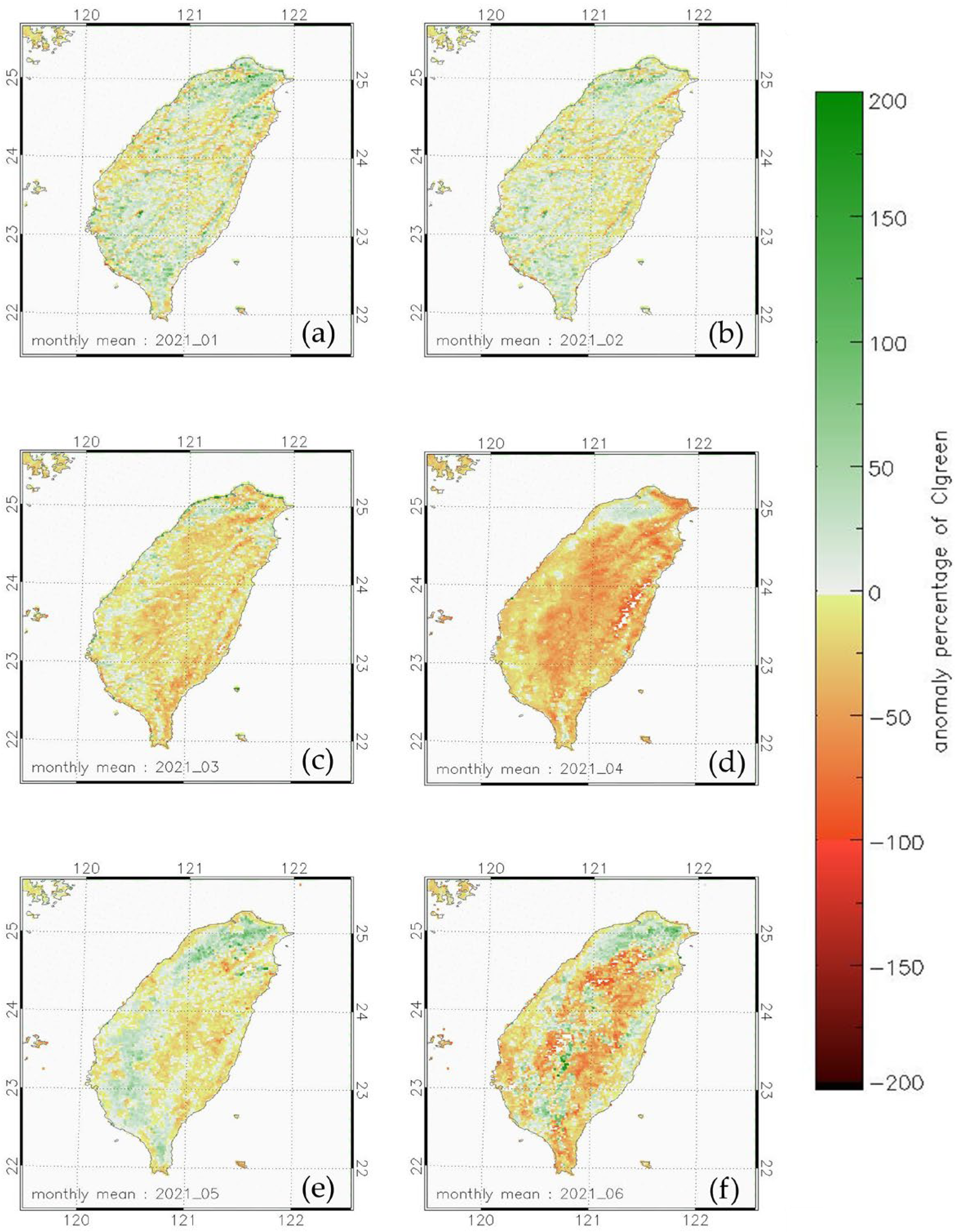
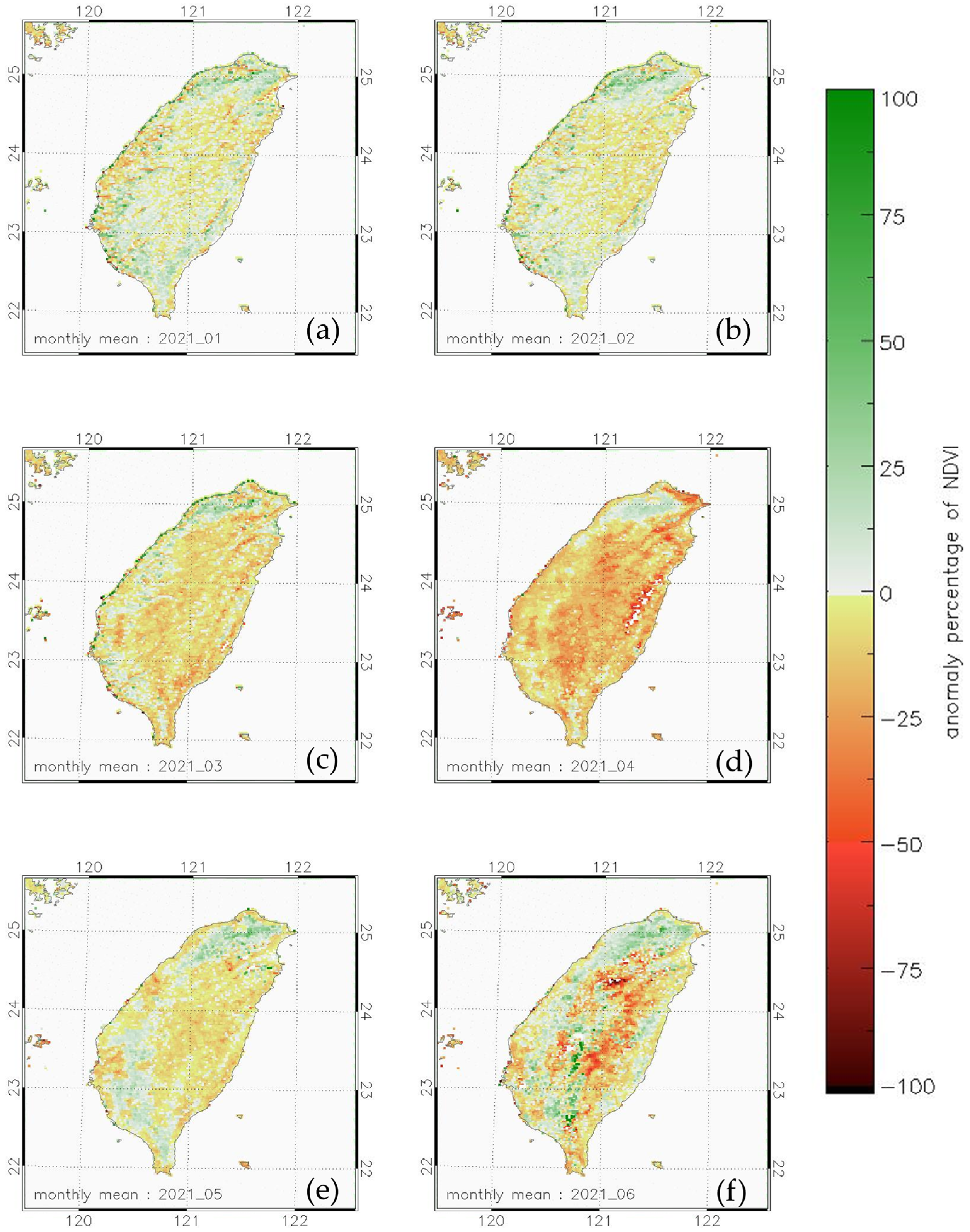
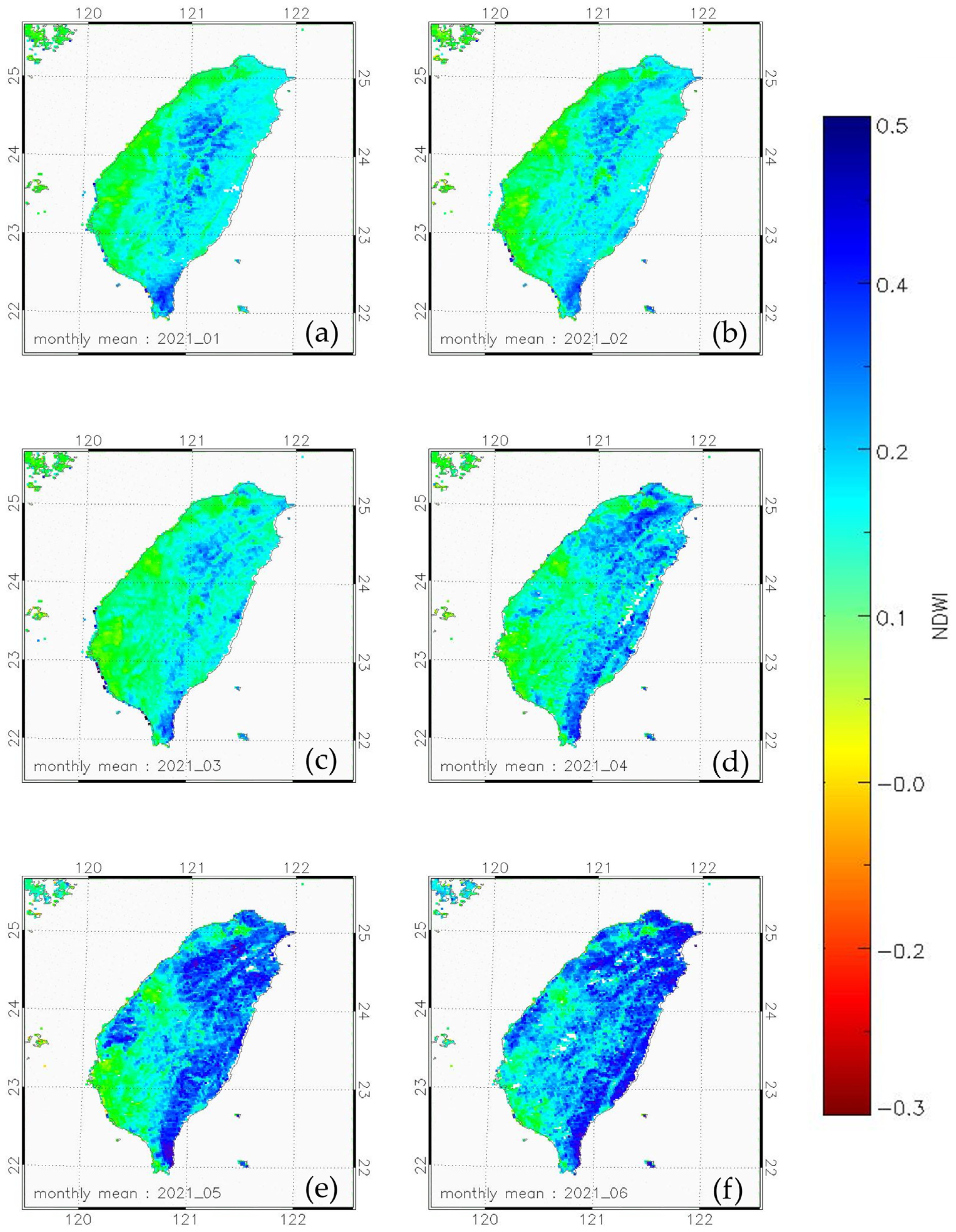

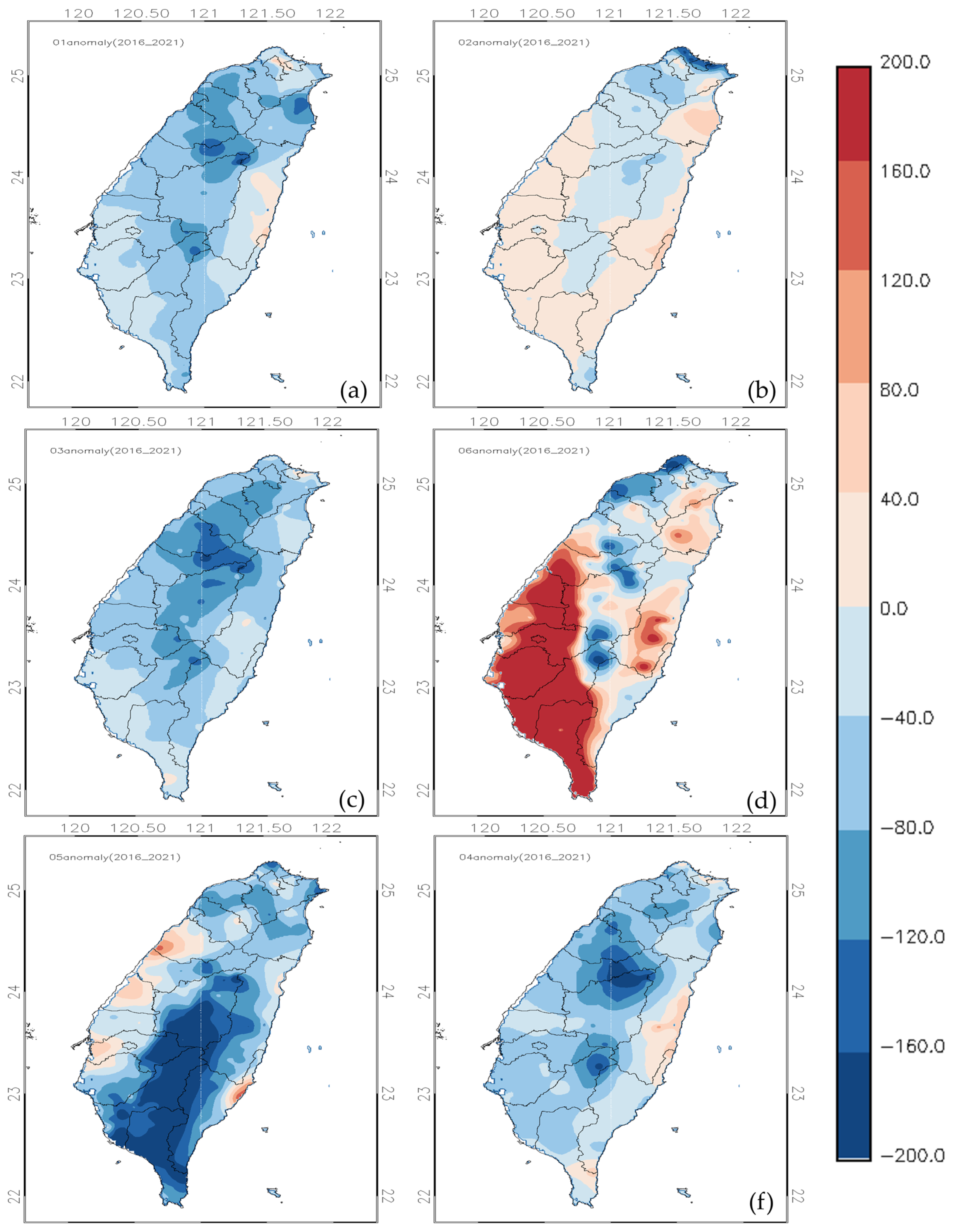
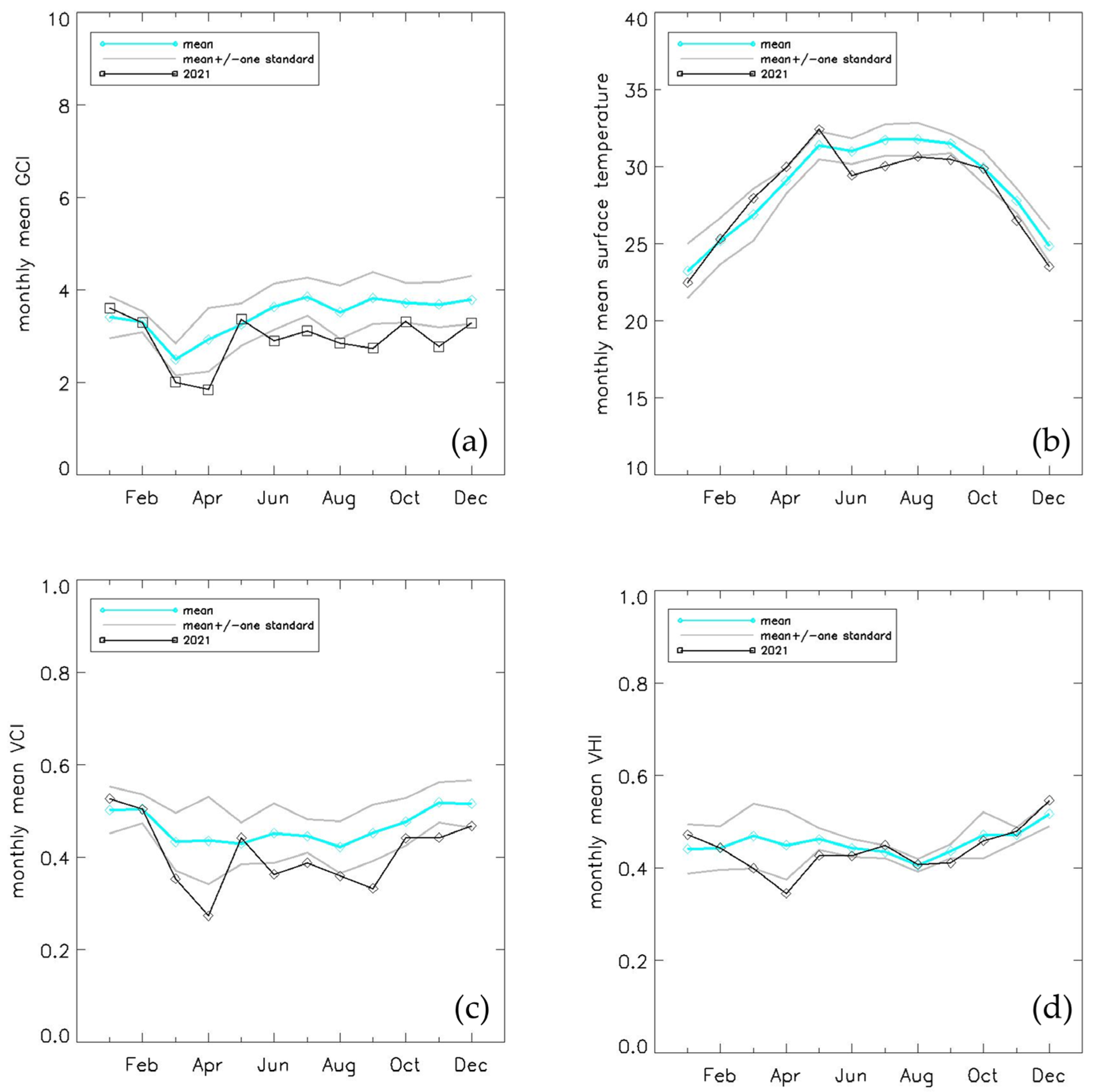
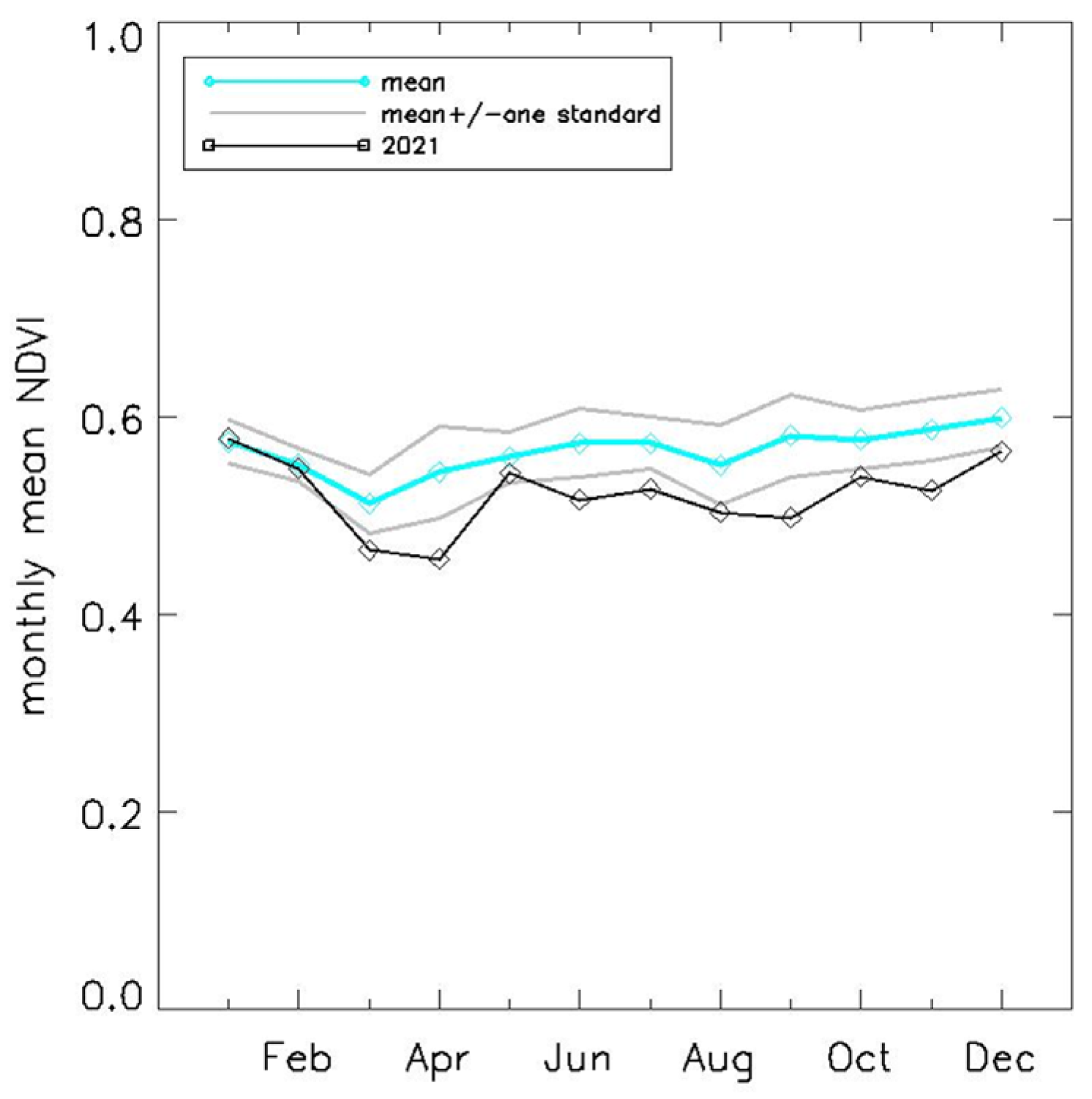
Publisher’s Note: MDPI stays neutral with regard to jurisdictional claims in published maps and institutional affiliations. |
© 2022 by the authors. Licensee MDPI, Basel, Switzerland. This article is an open access article distributed under the terms and conditions of the Creative Commons Attribution (CC BY) license (https://creativecommons.org/licenses/by/4.0/).
Share and Cite
Chou, C.-B.; Weng, M.-C.; Huang, H.-P.; Chang, Y.-C.; Chang, H.-C.; Yeh, T.-Y. Monitoring the Spring 2021 Drought Event in Taiwan Using Multiple Satellite-Based Vegetation and Water Indices. Atmosphere 2022, 13, 1374. https://doi.org/10.3390/atmos13091374
Chou C-B, Weng M-C, Huang H-P, Chang Y-C, Chang H-C, Yeh T-Y. Monitoring the Spring 2021 Drought Event in Taiwan Using Multiple Satellite-Based Vegetation and Water Indices. Atmosphere. 2022; 13(9):1374. https://doi.org/10.3390/atmos13091374
Chicago/Turabian StyleChou, Chien-Ben, Min-Chuan Weng, Huei-Ping Huang, Yu-Cheng Chang, Ho-Chin Chang, and Tzu-Ying Yeh. 2022. "Monitoring the Spring 2021 Drought Event in Taiwan Using Multiple Satellite-Based Vegetation and Water Indices" Atmosphere 13, no. 9: 1374. https://doi.org/10.3390/atmos13091374




